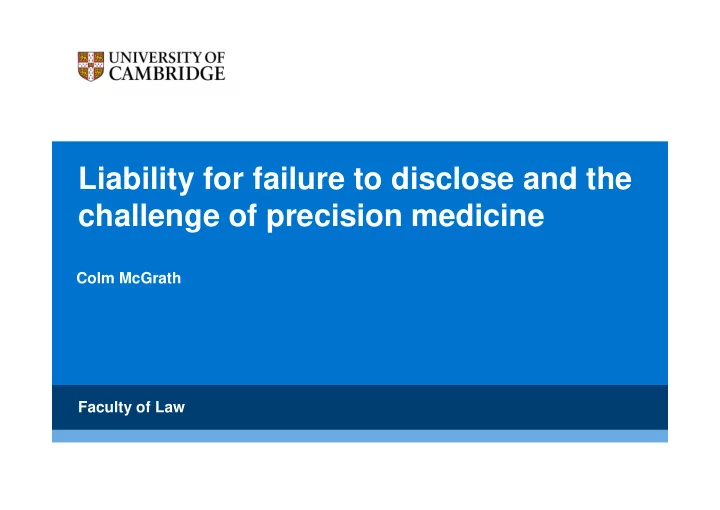

Liability for failure to disclose and the challenge of precision medicine Colm McGrath Faculty of Law
Identifying the tension in the law • Precision medicine vs disclosure duties • Montgomery v Lanarkshire Health Board (2015) Failure to advise on a C-section • ‘Duty to take reasonable care to ensure that the patient is aware of any material risks involved in any recommended treatment, and of any reasonable alternative or variant treatments ’ • Material risks are risks a reasonable person in the position of the patient would regard as significant • OR any risk which the doctor is, or should reasonably be aware the particular patient attaches significance to • Significance of a risk encompasses a broad range of factors, well beyond merely the statistical magnitude.
Who controls treatment options? • Traditionally seen as part of the overall clinical judgment • Measured against accepted, logically defensible practice • Guidelines from various sources often highly relevant (NICE, Royal Colleges, GMC)� but not binding on individual clinicians • The black and grey lists? • How many duties are there in Montgomery ? • 1. A single all encompassing duty judged against the two part test? • 2. One duty for inherent material risk, and one duty regarding alternatives?
The Broad view of Montgomery I • ‘The significance of a given risk is likely to reflect a variety of factors besides its magnitude: for example, the nature of the risk, the effect which its occurrence would have upon the life of the patient, the importance to the patient of the benefits sought to be achieved by the treatment, the alternatives available, and the risks involved in those alternatives. The assessment is therefore fact- sensitive, and sensitive also to the characteristics of the patient. ’ Montgomery per Lords Kerr and Reed at (89) • ‘In making a decision which may have a profound effect on her health and well- being a patient is entitled to information and advice about possible alternative or variant treatments .’ Chester v Afshar (2005) per Lord Steyn • ‘ I use the word advice to cover information as to risk and the options of alternative treatment .’ Sidaway v Bethlem Royal Hospital (1985) per Lord Scarman
The Broad view of Montgomery II • ‘…it is a non sequitur to conclude that the question whether a risk of injury, or the availability of an alternative form of treatment, ought to be discussed with the patient is also a matter of purely professional judgment.’ Montgomery per Lords Kerr and Reed at (83) • ‘Whenever the occasion arises for the doctor to tell the patient the results of the doctor's diagnosis, the possible methods of treatment and the advantages and disadvantages of the recommended treatment, the doctor must decide in the light of his training and experience and in the light of his knowledge of the patient what should be said and how it should be said.’ Sidaway per Lord Templeman • Birch v UCL Hospital Trust (2008) per Cranston J
The Narrow view of Montgomery • Conflicts with existing understandings of broader medical responsibilities • ‘ Ultimately, however, a patient cannot demand that a doctor administer a treatment which the doctor considers is adverse to the patient's clinical needs .’ Burke v GMC (2005) per Lord Philips • Aintree Hospital Trust v James (2013) • ‘ The existence of [the patient’s] entitlement [to decide to incur risk], and the fact that its exercise does not depend exclusively on medical considerations, are important. They point to a fundamental distinction between, on the one hand, the doctor's role when considering possible investigatory or treatment options and, on the other, her role in discussing with the patient any recommended treatment and possible alternatives, and the risks of injury which may be involved ’ Montgomery per Lords Kerr and Reed at (82) . • Meiklejohn v St George’s Healthcare Trust (2014)� Birch doubted • Tasmin v Barts Health NHS Trust (2015)� Guidelines are maps of the material risks
Limiting the Broad view • Five conditions to constrain the Broad view: • Treatments must have similar therapeutic aims • Treatments must have a different risk profile or invasive character • Scope of the duty narrows as treatment intensifies • Clinician need reasonably be aware of the existence of the alternative as a treatment for the patient’s condition • The duty is confined to disclosure of information, the clinician cannot be made perform the suggested treatment.
What does this do to applying precision medicine? • The Narrow view is pretty straightforward� Clinician control but risks undermining the ratio of Montgomery generally. • The Broad view is much fuzzier…and risks undermining tacit resource allocation and flooding information • Should genomically-tailored treatment be significant pre se? • What about where tailored treatment is only available privately? • The law is well suited to its own verion of precision medicine • Is trusting the court a ‘Goldilocks’ solution?
Recommend
More recommend